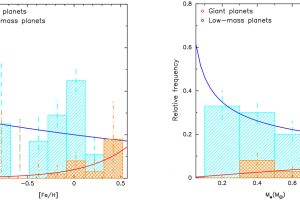The fraction of exoplanets as a function of stellar metallicity. The study: “HADES RV Programme with HARPS-N at TNG XII. The abundance signature of M dwarf stars with planets” of J. Maldonado (INAF-OAPA) recently appeared on A&A

The mechanisms involved in the formation of planets are still not completely understood. The most widely accepted model that describe the formation of gaseous planets is the core-accretion model. In this paradigm, the formation of these planets starts with the formation of a large rocky core by the coagulation of planetesimals, followed by the accretion of a large gaseous envelope as soon as the core is massive enough. These models is tested both with theoretical studies, and by verifying predicted relations with observations. The most important relation is the planets-metallicity relation, i.e. the observed larger fraction of gaseous planets in stars with larger metallicity (which in astronomy is the abundance of elements heavier than Hydrogen and Helium, called “metals”), predicted by the core-accretion model.
The larger fraction of gaseous planets in stars with increasing metallicity has been observed in stars of spectral classes FGK (i.e. with temperature between 7500 and 3700 K). However, this relation has not been validated yet for smaller and colder M stars, despite the numerous surveys dedicated to the search of exoplanets around this class of stars. One of the big difficulties in this sense is due to the presence of wide and deep molecular bands in the spectra of M stars, which blend with and hide lines useful to determine stellar metallicity. Besides, M stars are typically faint, requiring long exposures to obtain spectra with good signal-to-noise ratio.
The astronomer J. Maldonado (INAF-Astronomical Observatory of Palermo) led a study aimed at determining the relation between the presence of planets (both gaseous and rocky planets) and both mass and metallicity of 204 M stars, observed with the “twin” spectrographs HARPS of the European Southern Observatory and HARPS-N of INAF- Telescopio Nazionale Galileo in the framework of projects aimed at finding and characterizing exoplanets. In this study, stellar metallicity is determined with a new Bayesian method of analysis of spectral features and line ratios. This method has allowed the authors to extend the planets-metallicity relation valid for FGK stars also for M stars: the fraction of gaseous planets in fact increases at increasing stellar metallicity, while no relation is observed for rocky planets. A relation between the fraction of gaseous planets and stellar mass is also observed. This study, described in the paper: “HADES RV Programme with HARPS-N at TNG XII. The abundance signature of M dwarf stars with planets“, recently appeared on the journal Astronomy & Astrophysics, extend the observed relations supporting the core-accretion model from the FGK stars to the M spectral class. Among the coauthors, the astronomers G. Micela, L. Affer, A. Maggio, D. Locci, C. Di Maio, and A. Petralia f INAF-Astronomical Observatory of Palermo together with colleagues of Italian and Spanish institutes.
The figure (cick here to visualize the entire image) shows the fraction of stars with gaseous and rocky planets as a function of stellar metallicity (measured from the abundance of Iron over Hydrogen, the Fe/H ratio) and mass. The lines mark the best fit relations.
Mario Giuseppe Guarcello ( follow mguarce)
